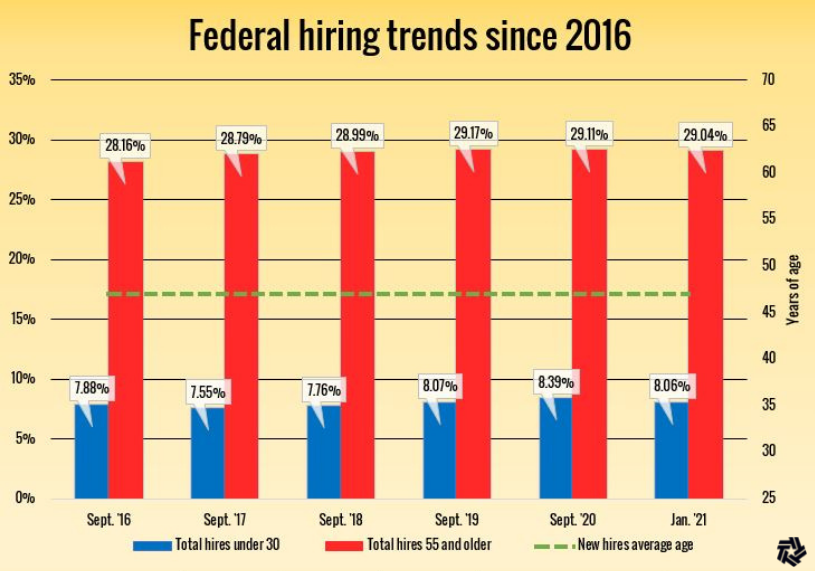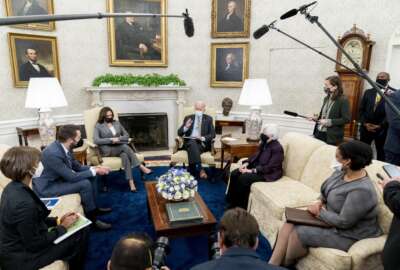
Biden proposes federal pay raise in 2022 budget
The Biden administration will recommend a 2.7% federal pay raise for civilian federal employees in 2022. The president's budget request also outlines a few steps...
President Joe Biden has recommended a 2.7% federal pay raise for civilian employees in 2022, according to his latest budget request.
The White House previewed the president’s initial 2022 budget request back in April but released the full proposal Friday.
The federal pay raise is designed to help agencies recruit and retain a diverse and inclusive workforce, the Biden administration said. A 2.7% bump is equal to the pay raise that the administration is proposing for active-duty military members next year.
Biden’s budget request doesn’t immediately make clear how locality adjustments might fit into the president’s federal pay proposal.
“A key priority for the administration was to ensure the president’s budget incorporated a healthy pay raise for the federal workforce and we plan to make this a priority with Congress,” an OMB official said in response to questions about locality pay plans. “We are currently evaluating a number of options ahead of a final decision on the amount to be communicated to Congress in the president’s alternative pay plan.”
A 2.7% federal pay raise, which Federal News Network first reported back in March, would be well above the 1% bump civilian employees received this year in 2021.
Former President Donald Trump proposed a 2.6% federal pay raise for 2020, which Congress ultimately raised to 3.1% in that year’s omnibus spending package.
The National Treasury Employees Union said it was “gratifying” to see the president’s federal pay raise proposal.
“This proposal is a solid start to achieving the fair pay increase federal employees deserve,” NTEU National President Tony Reardon said Friday in a statement. “We look forward to working with the administration and lawmakers to meaningfully recognize the contributions of the federal workforce, a bedrock of our democracy. Before, during and after the pandemic, these civil servants always step up to meet the missions of their agencies and the needs of taxpayers.”
Still, a 2.7% federal pay raise is slightly below what a group of House and Senate Democrats have proposed for next year via new legislation. The Federal Adjustment of Income Rates (FAIR) Act calls for a 3.2% pay raise for civilian employees in 2022, a proposal which NTEU, the American Federation of Government Employees support.
“While we are supportive that the long tradition of military-civilian pay raise parity has been honored in the president’s proposal, 2.7% is simply not nearly enough to compensate for the losses in buying power of federal wages and salaries over the past decade,” Everett Kelley, AFGE national president, said Friday in a statement.
The FAIR Act’s sponsor, Rep. Gerry Connolly (D-Va.), called the president’s budget proposal a “great start” but said Congress must do more.
“If we are going to recruit the next generation of public servants and be competitive with the private sector, Congress must pass the FAIR Act and give federal employees a 3.2% raise,” Connolly said.
A push to improve federal hiring, internships
Unlike previous years, the Biden administration is not proposing any major changes to federal employee health or retirement benefits in the budget request.
Instead, the budget calls for increasing capacity and building out the workforce at several civilian agencies.
The White House, for example, envisions a 9.6% increase in the number of employees at the Department of Housing and Urban Development and a 7.4% bump in the size of the Environmental Protection Agency workforce.
EPA’s headquarters and regional offices have experienced staffing declines in recent years and have struggled to balance research and program needs, the agency said.
The State Department would see the largest staffing increase in a decade, the Biden administration said.
“Workers have cried out for more staffing so that agencies can fulfill their mission without resorting to enormous amounts of mandatory overtime, and President Biden has heard them,” Kelley said. “AFGE is thankful that substantial staffing increases to multiple agencies were included in the president’s first budget. For far too long, our members have spoken out about the dangers of understaffing agencies such as the Department of Veterans Affairs, Bureau of Prisons and Transportation Security Administration.”
The Social Security Administration could see a 2.1% bump in the size of its workforce, while the Treasury Department could experience a 6.1% increase in the number of its employees.
Under the president’s proposal, the IRS could get enough funding to hire an additional 8,493 full-time employees over the current 2021 plan, according to NTEU.
“After decades of under-investment in a modern-day workforce, a failure to partner with labor unions, and ongoing, unwarranted attacks on its independence, the civil service is in need of repair and rebuilding and the administration has already taken swift action to deliver on that goal,” the president’s 2022 budget reads.
The Biden administration described a desire to achieve better hiring outcomes and modernize the personnel vetting and security clearance system, initiatives that were underway during the previous administration.
“As the administration and the country move forward, it is imperative that the federal government have the tools and human resources personnel to evolve and compete with the overall labor market,” the 2022 budget request reads. “The budget supports building additional capacity and capability for agencies to strengthen the workforce, recruit and hire talent and ensure agencies can recruit specific technical talent where there are longstanding gaps.”
Biden’s 2022 budget request offers up a few more details.
While the federal government has made progress on hiring individuals from underrepresented groups in recent years, the current makeup of the federal workforce doesn’t represent the overall civilian population, in part, due to complex civil service hiring rules.
The administration wants agencies to revitalize their internship programs and focus on recruiting young talent as the federal workforce continues to age.

Every agency has fewer employees under the age of 30 today than they did 10 years ago, the administration said, and the federal government as a whole is hiring fewer interns.
Agencies hired 60,000 paid interns in 2010 but just 4,000 in 2020, according to 2022 budget documents.
To revitalize intern programs, the administration wants agencies to identify current barriers and challenges to hiring interns. The budget specifically calls on agencies to find opportunities to increase the number of interns and include them in overall workforce planning.
Specifically, the budget calls on Chief Human Capital Officers Council Act agencies to create and fund “talent teams at the component level and to participate in or contribute to, as allowable, a centralized, government-wide hiring assessment support team to improve hiring outcomes for critical positions, including more technical or hard-to-fill positions.”
Federal News Network first reported the administration’s intention to create a new hiring assessment line of business in April.
The Office of Personnel Management, Office of Management and Budget and Chief Human Capital Officers Council also continue to work on “major workforce reforms,” the administration said.
OPM, for example, is preparing new guidance for agencies on hiring flexibilities to “facilitate a talent surge into government.”
“This work includes developing regulations to make it easier to bring back former employees by allowing agencies to rehire at a grade commensurate with the experience achieved while working outside of government, rather than limiting such employees to the grade level where they
were when they left,” the budget documents read.
OPM also plans to issue additional regulations on the Pathways Program, the administration said.
Copyright © 2025 Federal News Network. All rights reserved. This website is not intended for users located within the European Economic Area.
Nicole Ogrysko is a reporter for Federal News Network focusing on the federal workforce and federal pay and benefits.
Follow @nogryskoWFED
Related Stories
 Exclusive
Exclusive 



